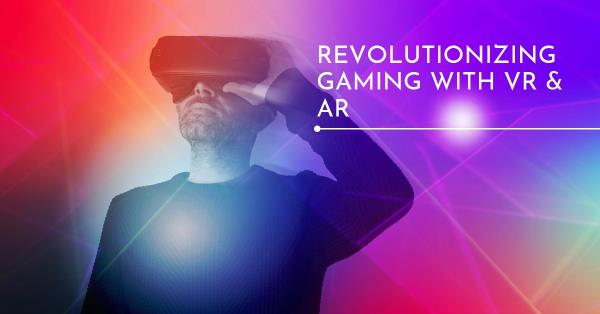VR & AR Revolutionize Gaming: Blurring the Lines in 2024

The gaming industry has always been at the forefront of technological innovation. From the pixelated worlds of early arcade cabinets to the hyper-realistic landscapes of today’s consoles, each generation has seen a leap forward in immersion and engagement. Now, in 2024, we’re witnessing a revolution driven by the convergence of virtual reality (VR) and augmented reality (AR) with traditional gaming platforms.
This integration is fundamentally redefining how we interact with games, promising experiences that transcend the limitations of a screen. Let’s delve into how VR and AR are being woven into the fabric of gaming platforms, and how these advancements are shaping the future of play.
VR: Stepping into the Game
VR technology transports players entirely into a virtual world. By donning a headset, users are enveloped in a 360-degree environment, fostering a level of presence unmatched by traditional gaming. This immersive experience isn’t just about visuals; VR incorporates spatial audio to create a truly three-dimensional soundscape, further blurring the lines between reality and the virtual world.
A recent study by [Newzoo](URL global games market report newzoo) projects that the VR market will reach a staggering $22.4 billion by 2024, highlighting its rapid growth and mainstream potential. Gaming platforms like SteamVR and PlayStation VR have become popular entry points, offering a diverse library of VR titles. These range from heart-pounding action adventures to social experiences that allow players to virtually connect and explore together.
For instance, the massively multiplayer online role-playing game (MMORPG) “Zenith: The Last City” utilizes VR to create a vast, shared world where players can embark on quests, forge alliances, and battle enemies alongside friends – all within a virtual realm. The sense of scale and physical embodiment VR provides adds a whole new dimension to this genre, fostering a deeper level of connection to the game and its community.
AR: Augmenting Our Reality
AR, on the other hand, overlays digital elements onto the real world through a smartphone or headset. Imagine exploring your city and encountering hidden creatures to capture, solving puzzles that utilize real-world landmarks, or even training for sports with superimposed virtual coaches. This technology injects a layer of interactivity into our everyday lives, blurring the line between the physical and digital.
The AR gaming market is expected to reach $8.6 billion by 2024, as reported by [Digi-Capital](URL ar and vr in gaming ON Digi-Capital digi-capital.com). A prime example of AR’s potential in gaming is the global phenomenon, Pokémon GO. This location-based AR game took the world by storm, encouraging players to explore their surroundings to capture virtual Pokémon. The game’s success demonstrates AR’s ability to bridge the gap between the digital and physical worlds, fostering social interaction and real-world exploration.
Cloud Gaming: Powering the Future of VR and AR
One of the biggest hurdles for widespread VR and AR adoption has been the processing power and hardware requirements. These technologies demand significant computing resources to deliver smooth, immersive experiences. This is where cloud gaming services like P99Soft come into play.
By leveraging the power of remote servers, cloud gaming platforms can eliminate the need for expensive, high-end hardware. Players can access VR and AR games directly through their existing devices, removing the barrier to entry for these innovative technologies. As VR and AR games become more complex and demanding, cloud gaming services like P99Soft will be instrumental in ensuring they remain accessible to a wider audience.
The Future of Gaming: A Seamless Blend of Worlds
The integration of VR, AR, and cloud gaming services is paving the way for a future where the boundaries between the physical and digital world are blurred entirely. Imagine training for a virtual marathon using AR overlays on your actual running route, or attending a live concert within a meticulously crafted VR environment. The possibilities are truly limitless.
FAQs
- Do I need a VR headset to play AR games? No, AR games are typically accessed through smartphones or tablets.
- Are VR games expensive? The cost of VR games can vary, but they generally fall within the same price range as traditional console or PC titles.
- Is VR safe for children? It’s recommended to follow age restrictions set by VR developers, as some experiences may be too intense for younger players.
- What kind of internet connection do I need for cloud gaming? A strong and stable internet connection is essential for a smooth cloud gaming experience.
- Will VR and AR replace traditional gaming? VR and AR offer unique experiences that complement traditional gaming, rather than replace it.
Conclusion
The convergence of VR, AR, and cloud gaming services is pushing the boundaries of immersion and engagement in the gaming world. These advancements hold the potential to revolutionize how we play, fostering deeper connections to game worlds and fostering a sense of presence unlike anything before. As technology continues to evolve and these platforms become more accessible, one thing is certain: the future of gaming is poised to be an exciting, ever-evolving blend of reality and the fantastical. But with so much innovation, where will this journey take us next?
Also know Peak Season Hero: E-commerce Testing for Smooth Sales



